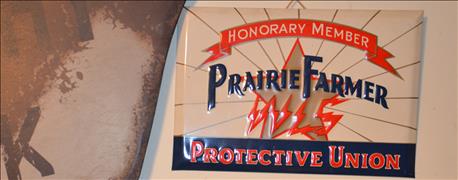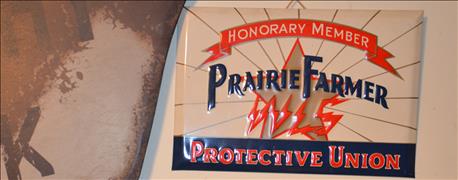
Prairie Farmer magazine was founded in 1841 in Illinois when early settlers still beat snakes off plows with a stick as they tilled the soil. For 175 years, Prairie Farmer has served farm families in Illinois, Indiana and other states.
Using items from the archives that each tell a story, here is a look at Prairie Farmer’s role in agriculture as it completes 175 years of service. Some of this information was gleaned from the sesquicentennial edition published in January 1991.
• Prairie Farmer Co. established the Protective Union.

STORY OF SERVICE: From its beginning in 1841, Prairie Farmer has been about providing information and service to readers in Illinois, Indiana and beyond.
In the early 1900s, automobiles gave more people access to rural areas. Not all who came were honest. Prairie Farmer officially organized the Protective Union in 1918 to "protect its readers against swindlers and crooks."
From 1920 through the 1960s, from four to six staff members handled over 100 letters a day. An investigator was hired to check out cases of livestock theft, trespassing and vandalism.
By the 1980s, agriculture had changed. The Protective Union continued and offered "No Trespassing" signs, but rewards for those caught were dropped.
The Protective Union is no longer active today.

STAY OUT! Many would-be crooks were deterred over the years by signs like these, offered to members of the Prairie Farmer Protective Union.
• Prairie Farmer offered chicken tattoo kits.
Everyone had chickens in the 1920s and 1930s, and they were easy targets for theft. Prairie Farmer developed the Prairie Farmer Poultry Marker. Kits sold for $2.50 each, with enough ink to do 100 birds and a personalized registration number. Chickens were tattooed in the breast area. Prairie Farmer kept registration numbers, and if a sheriff found chickens that were numbered, Prairie Farmer could verify who owned them. Apparently, the system held up in court.
A favorite chicken theft story from that era goes like this: A farmer noticed several chickens were missing, but he told no one. On Saturday at the feed mill, a loafer said, “Hey, did you ever catch your chicken thief?” The farmer answered, “I just did — it’s you. No one else knew.” Talk about caught red-handed!

THIEVES BEWARE: Chicken theft became a big deal in rural areas in the years before and during the Great Depression. An Indiana subscriber in New Castle received this Prairie Farmer tattoo kit in the mail.
• Prairie Farmer compiled breeder directories by county.
“Prairie Farmer's Reliable Directory of Breeders and Farmers" was published both before and after 1920. These directories were promotional items for subscriptions. They were published in various counties in Illinois, Indiana and Wisconsin, but there are no records of exactly which ones were published.
Here’s a typical entry taken from the Johnson County, Ind., breeders' directory, Page 35: "Bechman, George E. (Bonnie B. Right), Ch George, Robert: Silver Poplar Stock Farm, Franklin R4, Nineveh Sec 1, T148a, Daniel Doty (1914), Mutual Tel. Franklin."
Translated, George E. Bechman moved to Johnson County in 1914 and was a tenant on the 148-acre Silver Poplar Stock Farm owned by Daniel Doty in Nineveh Township, Section 1. He and his wife, Bonnie Right Bechman, had two children, George and Robert. They were served by Mutual Telephone of Franklin.
Was the information reliable? Close, but not 100% accurate — George's wife’s maiden name was misspelled; it was actually Wright. Also, they only had one child at the time, George Robert, with Robert being the middle name. (George Robert was the author’s father.)

COUNTY DIRECTORIES: Prairie Farmer subscription agents in many counties compiled information about farmers, sold ads like this one and published a directory as a promotional item.
• Prairie Farmer-WLS published a centennial cookbook in 1941.
Celebrating 100 years of Prairie Farmer, the "Prairie Farmer-WLS Family-Tested Centennial Cook Book" was offered to readers in 1941. Using the mantra, "Favorite foods old and new, every recipe tried and true," it included recipes from WLS entertainers, complete with their pictures.
You could cook up French-Fried Sausages or Dried Beef Rolls, or try Grace Wilson’s Liver Dumplings. A fixture with WLS, she was described as "the girl with a million friends."
Paging through the copy in the archives, the author discovered this inscription: "To Florence, from mother" in his grandmother’s handwriting! Florence was the author’s aunt.
Were the recipes tried and true? Someone wrote in a change in one recipe in red ink in 1968!

WLS RECIPES: Prairie Farmer and WLS, the Chicago radio station owned by Prairie Farmer at the time, published a centennial cookbook in 1941. It’s shown next to a breeders' directory.
• An Indiana edition of Prairie Farmer preceded Indiana Prairie Farmer.
When Burridge Butler and Clifford Gregory revitalized Prairie Farmer from 1909 through the mid-1930s, Indiana became an even more important part of the magazine’s coverage area. The magazine also had subscribers in Wisconsin, Michigan and Ohio. There's no record of when, exactly, but an Indiana edition soon appeared. Indiana Prairie Farmer was split off as a separate publication in the late 1970s. By 1980, Farm Progress Companies, owned by ABC Broadcasting, included Prairie Farmer, Indiana Prairie Farmer, Wallaces Farmer in Iowa and Wisconsin Agriculturalist.

INDIANA EDITION: The Sept. 5, 1959, Indiana edition of Prairie Farmer honored Teachers of the Year from four states, including Illinois and Indiana. Carl Eiche, listed as the Indiana editor, was in his first year of service.
About the Author(s)
You May Also Like




